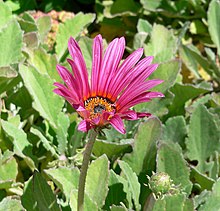
Amaryllis is the only genus in the subtribe Amaryllidinae. It is a small genus of flowering bulbs, with two species. The better known of the two, Amaryllis belladonna, is a native of the Western Cape region of South Africa, particularly the rocky southwest area between the Olifants River Valley and Knysna.

Protea cynaroides, also called the king protea, is a flowering plant. It is a distinctive member of Protea, having the largest flower head in the genus. The species is also known as giant protea, honeypot or king sugar bush. It is widely distributed in the southwestern and southern parts of South Africa in the fynbos region.

Gentiana acaulis, the stemless gentian, or trumpet gentian, is a species of flowering plant in the family Gentianaceae, native to central and southern Europe, from Spain east to the Balkans, growing especially in mountainous regions, such as the Alps and Pyrenees, at heights of 800–3,000 m (2,625–9,843 ft).

Carlina is a genus of flowering plants in the family Asteraceae. It is distributed from Madeira and the Canary Islands across Europe and northern Africa to Siberia and northwestern China.

Silene acaulis, known as moss campion or cushion pink, is a small mountain-dwelling wildflower that is common all over the high arctic and tundra and in high mountains of Eurasia and North America. It is an evergreen perennial flowering plant in the carnation family Caryophyllaceae.
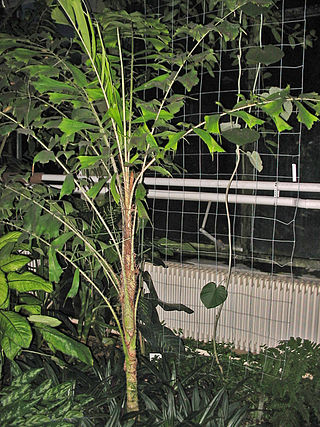
Aiphanes is a genus of spiny palms which is native to tropical regions of South and Central America and the Caribbean. There are about 26 species in the genus, ranging in size from understorey shrubs with subterranean stems to subcanopy trees as tall as 20 metres (66 ft). Most have pinnately compound leaves ; one species has entire leaves. Stems, leaves and sometimes even the fruit are covered with spines. Plants flower repeatedly over the course of their lifespan and have separate male and female flowers, although these are borne together on the same inflorescence. Although records of pollinators are limited, most species appear to be pollinated by insects. The fruit are eaten by several birds and mammals, including at least two species of amazon parrots.

Vernonia is a genus of about 350 species of forbs and shrubs in the family Asteraceae. Some species are known as ironweed. Some species are edible and of economic value. They are known for having intense purple flowers. There have been numerous distinct subgenera and subsections named in this genus, and some botanists have divided the genus into several distinct genera. For instance, the Flora of North America recognizes only about twenty species in Vernoniasensu stricto, seventeen of which are in North America north of Mexico, with the others being found in South America.
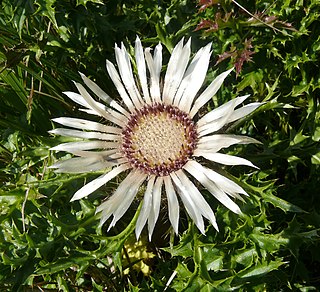
Carlina acaulis, the stemless carline thistle, dwarf carline thistle, or silver thistle, is a perennial dicotyledonous flowering plant in the family Asteraceae, native to alpine regions of central and southern Europe. The specific name acaulis and common names are descriptive of the manner in which its flower head rests directly upon a basal leaf rosette. The plant is named after Charlemagne who searched for a treatment against the plague. He dreamed of an angel who told him to shoot an arrow in the sky and see on what plant the arrow would hit. This plant would bring relieve to the plague. The plant the arrow hit was the Carlina acaulis, the roots of the plant were distributed among the population following which the plague diminished.
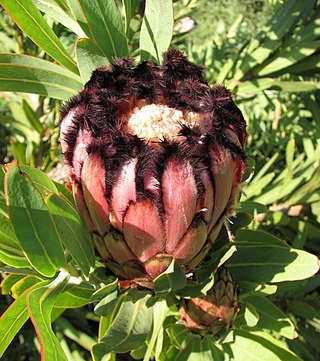
Protea neriifolia, also known as the narrow-leaf sugarbush, oleander-leaved sugarbush, blue sugarbush, or the oleanderleaf protea, is a flowering plant in the genus Protea, which is endemic to South Africa.

Ipomoea indica is a species of flowering plant in the family Convolvulaceae, known by several common names, including blue morning glory, oceanblue morning glory, koali awa, and blue dawn flower. It bears heart-shaped or 3-lobed leaves and purple or blue funnel-shaped flowers 6–8 cm (2–3 in) in diameter, from spring to autumn. The flowers produced by the plant are hermaphroditic. This plant has gained the Royal Horticultural Society's Award of Garden Merit.

Verbena bonariensis, the purpletop vervain, clustertop vervain, Argentinian vervain, tall verbena or pretty verbena, is a member of the verbena family cultivated as a flowering annual or herbaceous perennial plant. In USA horticulture, it is also known by the ambiguous names purpletop and South American vervain. For the misapplication "Brazilian verbena" see below.

A cushion plant is a compact, low-growing, mat-forming plant that is found in alpine, subalpine, arctic, or subarctic environments around the world. The term "cushion" is usually applied to woody plants that grow as spreading mats, are limited in height above the ground, have relatively large and deep tap roots, and have life histories adapted to slow growth in a nutrient-poor environment with delayed reproductivity and reproductive cycle adaptations. The plant form is an example of parallel or convergent evolution with species from many different plant families on different continents converging on the same evolutionary adaptations to endure the harsh environmental conditions.
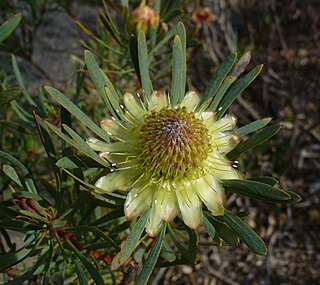
Protea scolymocephala, also known as the thistle protea or thistle sugarbush, is a flowering plant from the genus Protea native to South Africa.

Tetraneuris acaulis is a North American species of flowering plants in the sunflower family. Common names include angelita daisy, stemless four-nerve daisy, stemless hymenoxys, butte marigold, and stemless rubberweed.

Protea acaulos, also known as the common ground sugarbush, is a flowering plant found in the southwestern Cape Region, South Africa. It is also simply known as ground protea; in the Afrikaans language it is known as an aardroos.

Cymopterus glomeratus , now including Cymopterus acaulis, is a flowering plant. This plant is an aromatic plant of the family Apiaceae, a family of commonly known as the “celery, carrot, or parsley” family. The genus name comes from the Greek word, “Cyma” which means “wave” and “Pteron” which means “wing”, and combines to form the genus “Cymopterus”.

Ranunculus acaulis, in Australia and New Zealand called dune buttercup, sand buttercup or shore buttercup, is a yellow-flowered, small, fleshy herb, that grows in mats in damp places mostly near the sea. It occurs naturally in Australia, New Zealand, Chile and the Falklands. It flowers between August and April and sets seed from September till July.

Protea angustata, also known as the Kleinmond sugarbush, is a flowering shrub that belongs to the genus Protea. This plant is endemic to the south-west Cape Region of South Africa.

Crabbea is a genus of flowering plants native to eastern and southern Africa. They are generally low-growing perennial herbs. The five-petaled flowers are surrounded by prickly bracts.
